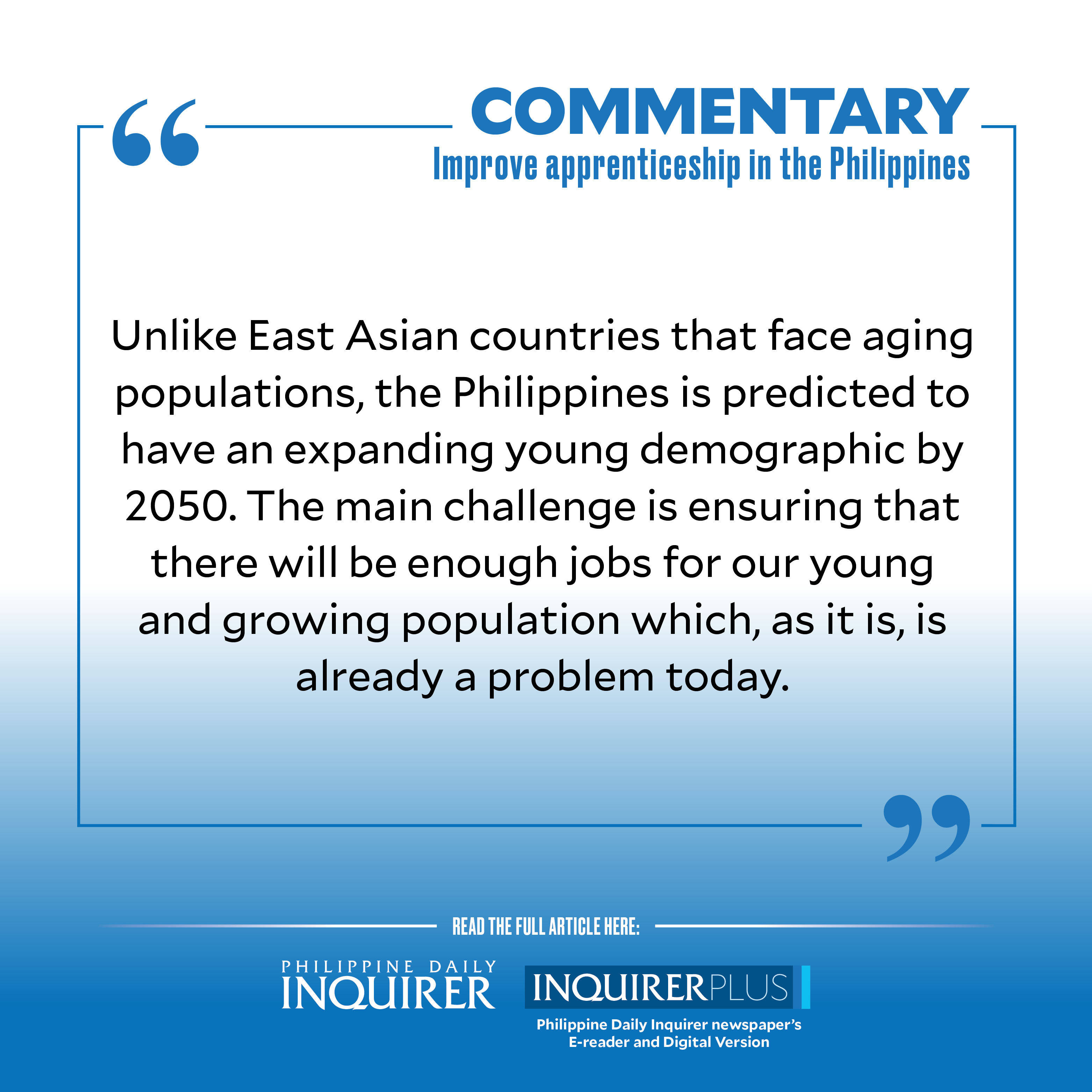Improve apprenticeship in the Philippines

Unlike East Asian countries that face aging populations, the Philippines is predicted to have an expanding young demographic by 2050. The main challenge is ensuring that there will be enough jobs for our young and growing population which, as it is, is already a problem today.
Unemployment rate for July 2023 was at a five-month high of 4.8 percent, translating to 2.3 million unemployed Filipinos. Meanwhile, underemployment for July 2023 increased to 15.9 percent, equivalent to 7.1 million Filipinos looking for additional sources of income.
Article continues after this advertisementThere are job opportunities, but workers cannot meet the skill demands of the market. A 2021 Asian Development Bank (ADB) study showed that 52 percent of Information Technology Business Process Outsourcing (IT-BPO) employers and 58 percent of employers in electronics manufacturing reported that graduates hired in the previous year had not been adequately prepared by their education or training due to the change of skills demanded by both sectors.
For example, communication skills that were initially the top requirement for IT-BPO jobs have been replaced by computer literacy and management skills due to evolving technology. Existing college and Technical-Vocational Education and Training modules may not be enough to keep up with the skills demand of the market.
Local training institutions do not frequently update their materials. The same ADB study found that 46 percent of training institutions surveyed only assess and update their curricula less than annually. Avilar Technologies, a workforce development company, noted that training programs should be updated more often. The study also observed a “severe misalignment” between training institutions’ expectations on what level of preparedness and skills the market requires vis-à-vis employers’ expectations on skills that applicants should possess.
Article continues after this advertisementCatching up with artificial intelligence (AI). A study by Oxford Economics and Cisco predicted that at least 4.5 million jobs, representing 10.1 percent of the labor force in the Philippines, can be displaced by 2028 due to the rise of AI. A recent report by the Commission on Human Rights also found that new graduates are finding it hard to get jobs, illustrating an existing skills gap that could grow if these issues are not addressed.
One way to address these concerns is to ramp up reskilling and upskilling programs as a form of human capital investment. These make workers more adaptable to changes, empower them in their work, and “future-proof” the labor force. Apprenticeship can help accelerate reskilling and upskilling, but the Philippines’ existing apprenticeship program enshrined in the labor code is outdated compared with those of our Southeast Asian peers.
In Singapore, apprenticeships are considered paid employment with the same benefits as regular employees. In response to the rise of AI, Singapore recently launched an “AI Apprenticeship Programme” to help workers meet the requirements needed in the AI field. Malaysia offers apprenticeships for specific skills and allows flexibility in training periods up to four years depending on the type of skill.
To encourage more companies to participate, we support the following proposed legislative amendments to the existing apprenticeship program:
The current law limits training to six months, but the bill seeks to remove the limit on the apprenticeship period, noting that the length of training should depend on the skill or curriculum.
The bill proposes that apprentices should not comprise more than 20 percent of total regular employees to help ensure that employers will not abuse the apprenticeship program.
Disability and accident insurance is currently not mandated, which the bill seeks to change. It is important for companies to provide insurance for apprentices as they learn new skills in an unfamiliar environment.
A training certificate, which apprentices can use to aid in getting employed, will be issued after the apprenticeship period.
We also suggest the following to improve the reformed apprenticeship package:
The registration of an apprenticeship program should be done in a prompt manner, with a reasonable turnaround time of 30 days, to encourage more companies to register with the Technical Education and Skills Development Authority (Tesda).
Allow industry apprenticeship councils to approve apprenticeship programs to ease the administrative burden on Tesda and to assure speedy accreditation.
The International Labor Organization has said that the “passage of the proposed law on apprenticeships may provide a significant opportunity for a major expansion of apprenticeships” in the Philippines. This is likely to happen if the approved version of the bill is structured in such a way that it will encourage more companies to participate.
It is important to also have safeguards, such as the proposed 20 percent cap in order to create a balance between utilizing apprenticeship to reskill and upskill Filipinos while ensuring that workers are not abused and the program is not taken advantage of. Once these improvements are made, the Senate should pass the proposed apprenticeship bill as soon as possible so many can benefit from the program.
—————-
Gary B. Teves served as finance secretary under the Arroyo administration.
















